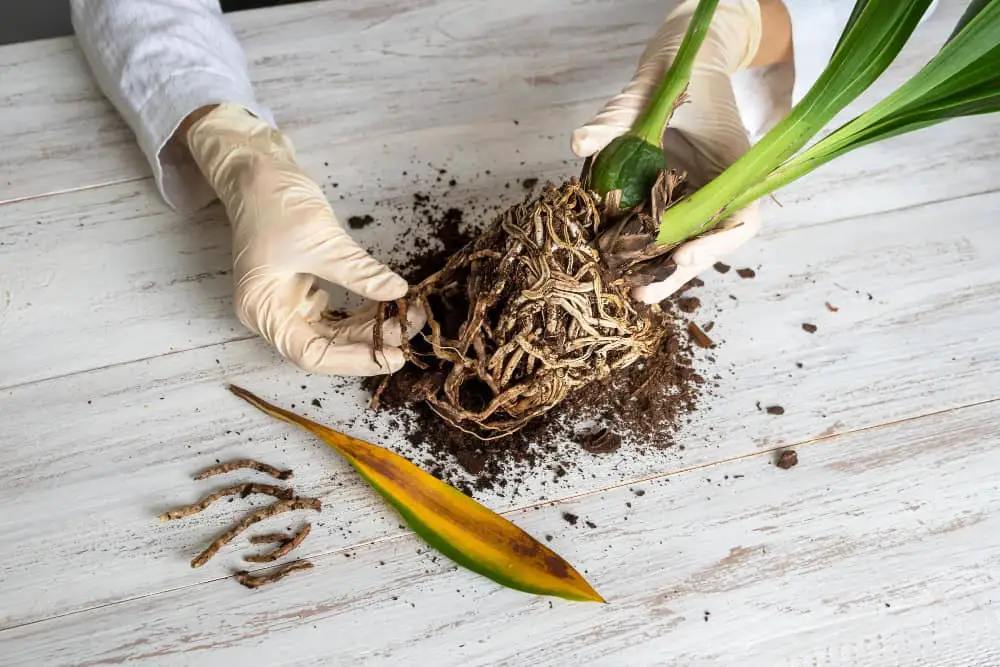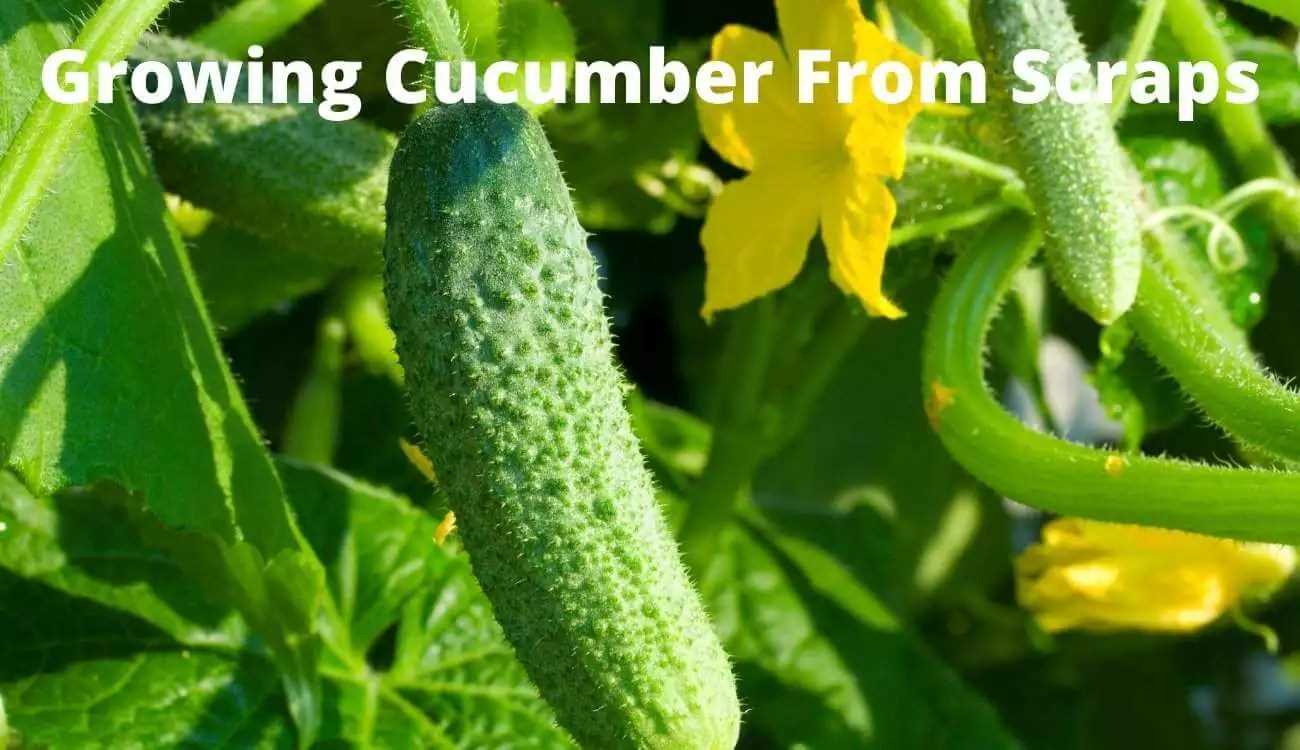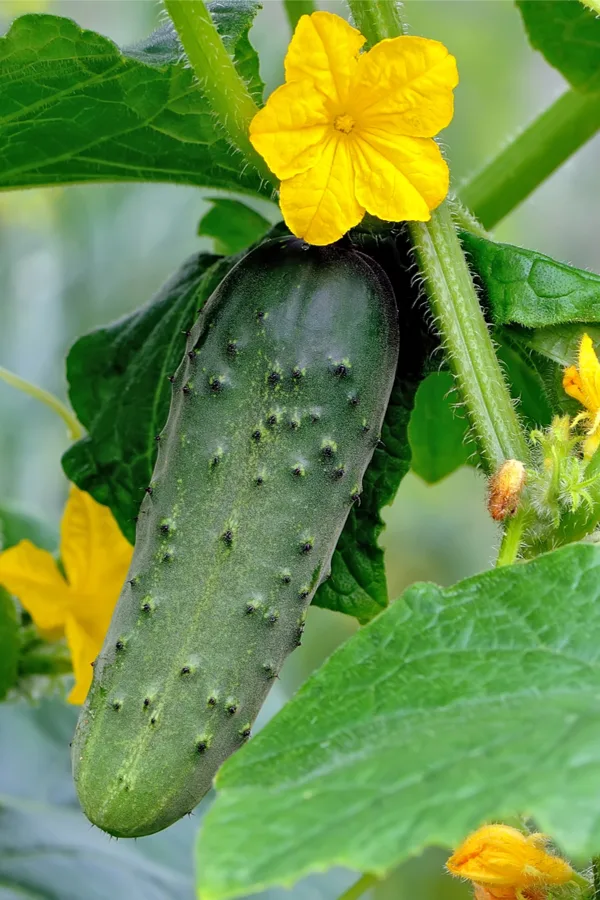- Understanding Cucumber Root Rot
- Causes
- Symptoms
- Prevention and Control
- Signs and Symptoms of Cucumber Root Rot
- Method 1: Proper Planting Techniques
- 1. Choose the Right Location
- 2. Rotate Crops
- 3. Improve Soil Quality
- 4. Adequate Spacing
- 5. Proper Watering
- 6. Mulching
- 7. Monitor and Remove Affected Plants
- 8. Practice Good Hygiene
- Method 2: Natural and Chemical Treatments
- Natural Treatments
- Chemical Treatments
- Preventing Cucumber Root Rot
- 1. Proper Soil Preparation
- 2. Crop Rotation
- 3. Proper Watering Techniques
- 4. Proper Plant Spacing
- Harvesting and Storing Cucumbers
- When to Harvest
- How to Harvest
- Storing Cucumbers
- Using Fresh Cucumbers
- “Question-Answer”
- What is cucumber root rot?
- How can I identify cucumber root rot?
- What causes cucumber root rot?
- Can cucumber root rot be prevented?
- How can I treat cucumber root rot?
- Is it possible to save cucumber plants affected by root rot?
- What should I do with the harvest from cucumber plants affected by root rot?
- “Video” Your Cucumber Plants Will DIE Every Time You Make This Mistake!
Cucumbers are a delicious and versatile vegetable that is enjoyed by many gardeners. However, one common problem that can plague cucumber plants is root rot. Root rot is a fungal disease that affects the root system of plants, causing them to deteriorate and eventually die.
Fortunately, there are a few effective methods you can use to save your cucumber plants from root rot and protect your harvest. The first method is to ensure proper drainage in your garden beds. Cucumber plants thrive in well-drained soil, so it’s important to make sure that water is able to flow freely through the soil and away from the plant’s roots. To improve drainage, consider amending your soil with organic matter, such as compost or well-rotted manure.
Another effective method to combat root rot in cucumber plants is to practice crop rotation. Crop rotation involves planting different crops in different areas of your garden each year, which helps to disrupt the life cycle of the fungi that cause root rot. By rotating your cucumber plants with other crops, such as beans or lettuce, you can greatly reduce the risk of root rot and promote overall plant health.
In conclusion, cucumber root rot can be a frustrating problem for gardeners, but with the proper methods, you can save your plants and preserve your harvest. By ensuring proper drainage and practicing crop rotation, you can prevent or mitigate the effects of root rot. With these strategies in place, you can enjoy a bountiful cucumber harvest year after year.
Understanding Cucumber Root Rot

Cucumber root rot is a common problem that can affect the growth and health of cucumber plants. It is caused by various pathogens, including fungi and bacteria, that attack the roots of the plants. Understanding the causes, symptoms, and prevention methods of cucumber root rot can help you save your plants and preserve your harvest.
Causes

- Overwatering: Excess water can lead to waterlogged soil, creating a perfect environment for pathogens that cause root rot to thrive.
- Poor Drainage: If your garden soil doesn’t drain well, it can also lead to waterlogged conditions that promote the growth of root rot pathogens.
- Infected Soil: If your garden soil has previously been infected with root rot pathogens, new cucumber plants can easily become infected.
- High Humidity: High humidity levels can create a favorable environment for the growth of root rot pathogens.
Symptoms

- Wilting: Infected cucumber plants may exhibit wilting, where the leaves lose their turgidity and droop.
- Yellowing: The leaves may start to turn yellow, indicating a lack of nutrients reaching the plant due to root damage.
- Stunted Growth: Cucumber plants affected by root rot often show slowed or stunted growth.
- Browning and Decay: The roots of infected plants may turn brown, soft, and mushy as the disease progresses.
Prevention and Control
Preventing cucumber root rot involves implementing good cultural practices and taking preventive measures:
- Proper Watering: Avoid overwatering and ensure that your garden soil has good drainage to prevent waterlogged conditions.
- Healthy Soil: Use compost or organic matter to improve soil health, which can help prevent the growth of root rot pathogens.
- Rotate Crops: Avoid planting cucumbers or other susceptible plants in the same location year after year to minimize the risk of reinfection.
- Sanitation: Remove and destroy any infected plants to prevent the spread of the disease.
- Fungicides: In severe cases of root rot, fungicides may be necessary to control the disease. Consult with a local gardening expert or extension office for specific recommendations.
By understanding the causes, symptoms, and preventive measures of cucumber root rot, you can effectively protect your cucumber plants and preserve your harvest. Regular monitoring, proper watering, and maintaining healthy soil can go a long way in preventing and controlling this destructive disease.
Signs and Symptoms of Cucumber Root Rot
Cucumber root rot is a common fungal disease that affects cucumber plants, causing significant damage to their roots. It is important to identify the signs and symptoms of root rot early on to prevent further spread and preserve the health of your plants. Here are some common signs to look out for:
- Wilting: Affected cucumber plants may exhibit wilting, where the leaves become droopy and lose their turgidity. This wilting can occur even when the soil is moist and the plants have been adequately watered.
- Yellowing Leaves: As the disease progresses, the leaves of affected plants may start to turn yellow. This yellowing can appear in patches or spread throughout the entire plant.
- Stunted Growth: Cucumber plants with root rot may exhibit stunted growth, staying smaller than healthy plants of the same age.
- Poor Fruit Development: Root rot can significantly affect fruit development, resulting in smaller, misshapen, or underdeveloped cucumbers.
In addition to these visible signs, cucumber plants with root rot may also exhibit root discoloration and a rotten smell in severe cases. It is important to note that these symptoms can also be caused by other diseases or environmental factors. Therefore, it is essential to closely monitor the health of your plants and consult a gardening expert if you suspect root rot.
Method 1: Proper Planting Techniques
Proper planting techniques are crucial in preventing cucumber root rot. By following these guidelines, you can minimize the risk of your cucumber plants being affected.
1. Choose the Right Location
Start by selecting a well-drained location for planting your cucumber plants. Poor drainage can increase the likelihood of root rot, so avoid areas with heavy clay soil or locations that tend to stay wet for extended periods.
2. Rotate Crops
Practice crop rotation to prevent the build-up of pathogens in the soil. Avoid planting cucumbers in the same spot for consecutive years as this can increase the chances of root rot development.
3. Improve Soil Quality
Before planting, prepare the soil by adding organic matter such as compost or well-rotted manure. This can improve soil quality, drainage, and fertility, creating a more favorable environment for your cucumber plants.
4. Adequate Spacing
Plant your cucumber seedlings with enough space between them to allow good airflow and reduce humidity around the plants. This can help prevent the growth of fungi that cause root rot.
5. Proper Watering

Avoid overwatering your cucumber plants as excess moisture can create favorable conditions for root rot development. Water the plants at the base, near the roots, and avoid wetting the foliage excessively.
6. Mulching
Add a layer of organic mulch, such as straw or wood chips, around the cucumber plants. Mulching can help regulate soil temperature, retain moisture, and reduce weed competition, promoting healthier root growth.
7. Monitor and Remove Affected Plants
Regularly inspect your cucumber plants for any signs of root rot. If you notice any plants exhibiting symptoms, such as wilting or discolored roots, remove them immediately to prevent further spread of the disease.
8. Practice Good Hygiene
Practice good garden hygiene by cleaning tools, pots, and other equipment before and after use. This can help prevent the introduction and spread of pathogens that cause cucumber root rot.
Method 2: Natural and Chemical Treatments
If you are dealing with cucumber root rot in your garden, there are several natural and chemical treatments that you can use to save your plants and preserve your harvest. These treatments target the root rot fungus and help to control its spread.
Natural Treatments
- Neem Oil: Neem oil is an effective natural treatment for cucumber root rot. It has antifungal properties that help to kill the root rot fungus. Dilute the neem oil according to the instructions on the bottle and spray it on the affected plants and surrounding soil. Repeat the treatment every 7-10 days until the root rot is under control.
- Garlic Spray: Garlic contains natural compounds that have antifungal properties. To make a garlic spray, finely chop a few cloves of garlic and soak them in water overnight. Strain the garlic and dilute the liquid with water. Spray the mixture on the affected plants and surrounding soil. Repeat the treatment every 7 days.
- Vinegar: Vinegar is another natural treatment that can help control cucumber root rot. Mix equal parts of vinegar and water and spray the solution on the affected plants and surrounding soil. The acidity of the vinegar helps to kill the root rot fungus. Repeat the treatment every 7 days.
Chemical Treatments
- Systemic Fungicides: Systemic fungicides are chemicals that are absorbed by the plants and travel through their vascular system, providing long-lasting protection against fungal diseases. Choose a systemic fungicide that is labeled for cucumber root rot and follow the instructions on the packaging for application.
- Soil Drench: Soil drench fungicides are applied directly to the soil around the affected plants. They are absorbed by the roots and help to control the root rot fungus. Choose a soil drench fungicide that is labeled for cucumber root rot and follow the instructions on the packaging for application.
- Copper-Based Fungicides: Copper-based fungicides are another option for controlling cucumber root rot. They work by interfering with the fungal cells and preventing their growth. Use a copper-based fungicide that is labeled for cucumber root rot and follow the instructions on the packaging for application.
When using any chemical treatments, it is important to follow the instructions carefully and wear protective clothing to avoid exposure to the chemicals. It is also a good idea to test the treatments on a small area of your plants before applying them to the entire garden.
By using these natural and chemical treatments, you can effectively control cucumber root rot and protect your plants from further damage. Remember to also practice good garden hygiene, such as removing and destroying infected plants, to prevent the spread of the fungus.
Preventing Cucumber Root Rot
Cucumber root rot can be a devastating disease for your cucumber plants, leading to stunted growth, wilted leaves, and ultimately the death of the plant. However, there are several preventative measures you can take to protect your cucumber plants from root rot and ensure a healthy harvest.
1. Proper Soil Preparation
One of the most important steps in preventing cucumber root rot is ensuring that the soil is well-prepared before planting. Start by testing the pH level of the soil and adjusting it to a range of 6.0 to 7.0, which is ideal for cucumber growth. Additionally, make sure the soil is well-draining to prevent waterlogged conditions that can promote the development of root rot.
Steps to Prepare the Soil:
- Remove any weeds or debris from the planting area.
- Loosen the soil using a garden fork or tiller, ensuring it is not compacted.
- Add organic matter such as compost or well-rotted manure to improve soil structure and drainage.
- Avoid over-watering the soil before planting, as excessive moisture can contribute to root rot.
2. Crop Rotation
Cucumber plants should not be grown in the same location year after year, as this can lead to the build-up of pathogens in the soil that cause root rot. Implementing a crop rotation system can help to reduce the risk of disease and maintain healthy cucumber plants.
Steps for Crop Rotation:
- Divide your garden into different plots or sections.
- Rotate cucumber plants with other non-susceptible crops, such as lettuce, beans, or corn.
- Avoid planting cucumbers in the same section of the garden for at least three years.
- Keep a record of the crops you’ve grown in each section to ensure proper rotation.
3. Proper Watering Techniques
Over-watering is a common cause of root rot in cucumber plants. It is important to water the plants deeply and infrequently, allowing the soil to dry out slightly between watering sessions.
Watering Tips:
- Water cucumber plants in the morning to allow the leaves to dry out during the day.
- Avoid overhead watering, as wet foliage can promote the development of fungal diseases.
- Use a drip irrigation system or a soaker hose to deliver water directly to the plant roots and minimize moisture on the leaves.
4. Proper Plant Spacing
Proper plant spacing is essential to prevent overcrowding and promote adequate air circulation around cucumber plants. Overcrowded plants can create a humid microclimate that favors the development of root rot.
Plant Spacing Guidelines:
| Type of Cucumber | Spacing Between Plants |
|---|---|
| Vining Cucumbers | 2 to 3 feet apart |
| Bush Cucumbers | 1 to 2 feet apart |
By following these preventative measures, you can significantly reduce the risk of cucumber root rot and enjoy a bountiful cucumber harvest. Remember to monitor your plants regularly for any signs of disease and take immediate action if you suspect root rot.
Harvesting and Storing Cucumbers
After months of hard work and careful nurturing, it’s finally time to harvest your cucumbers. Here are some tips to help you get the most out of your harvest and properly store your cucumbers for later use.
When to Harvest
Cucumbers should be harvested when they reach their desired size. This varies depending on the type of cucumber you’re growing. For slicing cucumbers, harvest when they are 6-8 inches long. Pickling cucumbers are typically harvested when they are 2-4 inches long. Be sure to check the seed packet or plant label for specific instructions on when to harvest your particular variety.
It’s important to harvest cucumbers regularly, as leaving them on the vine for too long can cause them to become overripe and lose their crispness. Aim to harvest cucumbers every 2-3 days during peak production.
How to Harvest
To harvest cucumbers, gently hold the fruit and cut the stem just above the cucumber with a pair of sharp garden scissors or pruners. Avoid pulling or twisting the cucumber, as this can damage the plant. It’s best to harvest cucumbers in the morning when they are cool and hydrated, as this will help preserve their freshness.
Storing Cucumbers
If you plan to use your cucumbers within a few days of harvesting, store them in the refrigerator to maintain their freshness. Place them in a sealed plastic bag or wrap them in a damp paper towel to help prevent moisture loss.
Cucumbers can also be stored for a longer period by pickling or canning them. Pickling cucumbers are ideal for this purpose, as their smaller size and firm texture make them perfect for pickling. Follow a trusted recipe for pickling or canning cucumbers, ensuring that proper sterilization techniques are followed.
Using Fresh Cucumbers
Freshly harvested cucumbers are perfect for adding a crisp and refreshing component to salads, sandwiches, or as a snack on their own. They can be sliced, diced, or shredded depending on your preference. Experiment with different recipes and enjoy the taste of your homegrown cucumbers!
Remember, the key to successful cucumber harvesting and storage is to handle them with care, store them properly, and enjoy them at their peak of freshness. With these tips in mind, you can savor the fruits of your labor for weeks to come.
“Question-Answer”
What is cucumber root rot?
Cucumber root rot is a fungal disease that affects the roots of cucumber plants, causing them to rot and eventually die.
How can I identify cucumber root rot?
Cucumber root rot can be identified by wilting and yellowing leaves, stunted growth, and a foul smell around the roots.
What causes cucumber root rot?
Cucumber root rot is caused by various fungi, including Pythium and Phytophthora, which thrive in damp and poorly-drained soil.
Can cucumber root rot be prevented?
Yes, cucumber root rot can be prevented by practicing good sanitation, improving soil drainage, and avoiding over-watering.
How can I treat cucumber root rot?
To treat cucumber root rot, you can try using a commercial fungicide or natural remedies such as neem oil or cinnamon powder. It’s also important to remove and destroy infected plants to prevent the spread of the disease.
Is it possible to save cucumber plants affected by root rot?
In some cases, it may be possible to save cucumber plants affected by root rot by removing the infected roots, improving soil drainage, and treating with fungicides. However, prevention is always better than cure.
What should I do with the harvest from cucumber plants affected by root rot?
If your cucumber plants are affected by root rot, it’s best to dispose of the harvest to prevent the spread of the disease. Do not consume the affected cucumbers.







